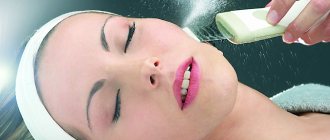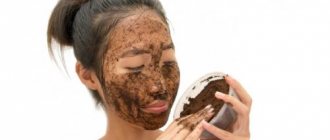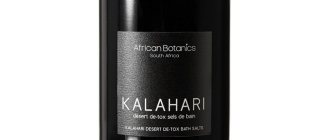Currently, phonophoresis in cosmetology is used more and more often. When using this technique, various beneficial substances are introduced into the skin, which moisturize, nourish and restore it.
- Indications for the procedure
- Phonophoresis and its application
- Carrying out the procedure
- Phonophoresis and its contraindications
- Benefits of phonophoresis
- Ultraphonophoresis devices
If ultraphonophoresis is used, then ultrasonic waves are also used, which allow medicinal substances to penetrate into the deep layers of the epidermis. The procedure has a comprehensive effect on the skin of the face, because... includes micromassage and ultrasonic lymphatic drainage. Thanks to them, the dermis is even more saturated with useful substances.
Ultraphonophoresis is suitable for both young and aging skin; you just need to adjust the operating mode of the device. For example, for rosacea or for sensitive skin, a non-thermal (pulse) mode is used.
Features of phonophoresis
Phonophoresis
– a combined effect on the body
of ultrasound
and a medicinal substance applied to the skin or mucous membranes.
The basis for the development and implementation of the method in clinical practice was primarily information about the ability of ultrasound
to loosen connective tissue, increase the permeability of the skin and histohematic barriers, increase diffusion and potentiate the effect of medicinal substances (DS), as well as enhance transcapillary transport of liquids and substances soluble in them.
During the procedure, the medicinal substance is included in the contact medium. When sonicated, the medicinal substance retains its structure and pharmacotherapeutic activity, its action is unidirectional with the action of ultrasound
, which ensures a synergistic effect on the body.
The introduction of a medicinal substance into the body during phonophoresis
is carried out through the excretory ducts of the sweat and sebaceous glands, transcellular and intercellular routes.
Ultrasonic vibration frequency for phonophoresis
is of particular importance: the lower the
ultrasound
, the greater the quantity of the drug entering the body.
The ability of tissues to absorb ultrasonic vibrations is also important - acoustics. Border tissues (for example, skin and subcutaneous tissue) have the best acoustic ability.
Active substances used during the procedure
Use a composition with a creamy consistency. Phonophoresis with hydrocortisone at home is effective for osteochondrosis. In addition, it is used in cosmetology to eliminate wrinkles, thanks to which the method has gained particular popularity among mature women.
If there are postoperative scars, lidase phenophoresis is the right choice to eliminate them. Compositions with collagenolytic enzyme destroy scar tissue. The preparations may also contain phytoextracts and other components. The proportion of active substance is only up to 3%. The depth of impact of particles is determined by their structure and the frequency of ultrasonic waves.
The basic base should not change the structure of the medicinal composition. In this way, aloe extract is often administered as a biostimulant and interferon to increase antiviral immunity.
To eliminate skin problems, medications with 3 intensity levels are used. It must be determined depending on the initial problem and the condition of the epidermis. Exceeding the level can result in burns. Therefore, such devices must be used at home with extreme caution.
Benefits of phonophoresis
- Ultrasound therapy
actively saturates tissues with oxygen, increases the elasticity of connective tissues, rejuvenates and regenerates cells, increases tissue turgor, tones muscles, provides microheating and tissue massage, creating a lifting effect. - The drug injected under the skin acts for a long time after the procedure.
- With the help of phonophoresis,
you can quite effectively reduce swelling, increase blood circulation, remove metabolic products from cells, and improve lymphatic drainage.
detailed instructions
- Using a special soft brush (often included with a medicinal product), apply a cosmetic product to your face.
- Set the desired mode and wave power on the device. Information about this can be read in the instructions for the equipment. Any portable ultrasound device should be equipped with detailed instructions in Russian. Phonophoresis should be carried out according to the attached manual.
- Then the electrode of the device should move along the massage lines along the face, making circular and linear movements.
The procedure can be carried out either in continuous or pulsed mode. During operation, you can smoothly change the power and frequency of sound waves. This facilitates the penetration of nutrients and medications to different depths of the skin. The duration of the first operation should not exceed 10-15 minutes. Later it can be increased to half an hour. - After the procedure, you need to apply any moisturizing or nourishing cream to your face.
Phonophoresis cannot be done often. It is permissible to use this method no more than three times a week. In this case, the course of therapy should be half a month. Then there is a break. Its duration should be at least 2-3 weeks. It is also possible to carry out a course of 5-15 procedures with an interval of several days. In this case, the break should be from 3 to 5 months.
Indications for phonophoresis
Indications for phonophoresis
determined by the pharmacotherapeutic properties of medicinal substances and indications for the use of ultrasound.
The most common of phonophoresis
are:
- for diseases and injuries of joints;
- for diseases of the peripheral nervous system;
- for osteochondrosis of the spine with neurological manifestations;
- for sports injuries;
- for eye diseases;
- for vascular diseases;
- in dermatology;
- in postoperative rehabilitation of patients, etc.
Indications and contraindications
This technique for cosmetic purposes is indicated if:
- cellulite;
- wrinkles;
- stretch marks;
- folds;
- pigmentation;
- scars.
Contraindications include hypersensitivity to ultrasonic waves, intolerance to the drugs used, and purulent skin diseases. You should also refuse if you have cancer. Avoid this technique during pregnancy and breastfeeding.
If you have rosacea and hematomas, you should postpone this method of skin healing for later and perform it only after recovery.
Phonophoresis at GUTA CLINIC
Phonophoresis in Moscow
today they are carried out not only by various medical institutions, but also by beauty salons, where the procedure is often carried out in violation of sanitary standards by uncertified specialists who do not have sufficient qualifications to carry out the procedure.
We do not urge you to give up going to beauty salons completely, we simply remind you that phonophoresis
is primarily a medical procedure, which is best done by an experienced physiotherapist. Otherwise, not only is a sufficient therapeutic effect not guaranteed, but negative consequences of such exposure, for example, an allergic reaction to the drug used, cannot be excluded.
Only a competent specialist, having familiarized himself with the results of your examination and having sufficiently complete information about your health, will help you select and conduct for you the necessary course of phonophoresis
in accordance with all requirements imposed by the Ministry of Health of the Russian Federation.
GUTA CLINIC employs highly qualified specialists with extensive experience in the successful use of phonophoresis
in the treatment of a wide range of different diseases.
Sign up for phonophoresis now, and tomorrow your family and friends will note how you have changed and become prettier!
Phonophoresis: contraindications
To achieve such results, you need to know that phonophoresis has contraindications, in which this procedure can harm rather than help. These include:
- arrhythmias of any type;
- circulatory failure;
- blood diseases;
- electronic implants;
- oncological diseases;
- wounds, abrasions and ulcers on the treated area of the face that have not yet healed;
- purulent processes on the face;
- mental illness;
- pregnancy;
- increased body temperature;
- colds and infectious diseases.
Such a large list of contraindications for phonophoresis only confirms its high effectiveness and active impact on the processes occurring under the skin.
Methodology of the procedure
Phonophoresis does not require preparation. Stages of the procedure:
- Treating the skin with an antiseptic and applying a medicinal composition.
- Impact on the area with the device. The device is moved along the surface or at a distance of 1–2 cm. The speed of movement of the emitter is 1–2 cm/s.
- During the process, you can change the power - this improves the penetration of substances inside.
The course of treatment is 10–15 procedures, 3–15 minutes each. After phonophoresis, the increased sensitivity of tissues persists for 2–3 hours, so it is advisable not to wash off the applied substance or wipe it off with a napkin.
Article on the topic: Antidepressant Fluvoxamine: indications, instructions, reviews
Effect of phonophoresis
Ultrasound has a massaging effect on the tissue, which stimulates blood circulation. Hydrocortisone and other active substances relieve swelling and initiate processes that ensure tissue regeneration.
The results become noticeable after the first procedures: the functioning of the sebaceous glands slows down, which leads to the disappearance of oily sheen. At the end of the course of treatment, the skin becomes not only clean and smooth, but also responds better to moisturizing and nourishing creams, and absorbs nutrients more easily. The effect of ultrasound in combination with cosmetics eliminates acne, wrinkles and scars, makes the skin firm and elastic, and gives it a natural color.
The procedure does not cause pain, does not irritate the skin, and has no side effects. In addition, it does not require a rehabilitation period: immediately after the session you can go about your daily activities. The use of phonophoresis is possible for dry, problematic and sensitive skin that requires special care.
The duration of the procedure is 5-30 minutes, which depends on the area of skin being treated. The course of treatment consists of 10-12 sessions, with 1-3 day breaks between them.
Results of the procedure
- Elimination of facial swelling.
- Reduction of expression lines and age wrinkles.
- Tightening the oval of the face.
- Normalization of the secretion of the sebaceous glands.
- Reducing acne.
- Disappearance of “black dots” on the skin.
- Improved complexion.
- Increases skin firmness and elasticity. It becomes more even, smooth, and takes on a fresh look.
- Narrowing of pores.
Ultrasound phonophoresis is, without a doubt, an effective way to restore your skin to a healthy appearance, shine and rid it of acne and blackheads. But you should keep in mind that you should not expect instant results here. The effect of the procedures can be seen after 5-6 sessions.
Contraindications
There is an extensive list of contraindications to ultrasound with hydrocortisone. In this case, contraindications to the procedure itself and to hydrocortisone as a drug should be considered separately.
Important! In view of such circumstances, the therapeutic course should be prescribed only by a doctor after a comprehensive examination.
An ultrasound physiotherapeutic procedure is prohibited in the following situations:
- pregnancy period,
- pathologies of the cardiovascular system,
- neoplasms of benign and malignant nature,
- diabetes,
- renal failure,
- bronchial asthma,
- pathologies associated with blood clotting disorders,
- nervous disorders,
- malfunction of the endocrine glands,
- immunodeficiency,
- infections, inflammatory processes that require active functioning of the immune system.
Hydrocortisone should not be used under the following circumstances:
- Individual intolerance to the components of the product.
- Violations of the integrity of the skin at the site of the procedure.
- Pregnancy and breastfeeding.
- Severe forms of tuberculosis, diabetes.
- Dermatological pathologies - ulcers, dermatitis, rash.
In rare cases, this procedure can cause adverse reactions in the form of itching, swelling and hyperemia in the area affected by the device. There have also been cases of increased blood pressure.
Preparations for phonophoresis
It is known that this procedure has a destructive effect on substances such as vitamin C, caffeine, novocaine, B vitamins, as well as protein preparations. Therefore, only special cosmetics and medications should be used to carry it out. Often these products will state that they can be used for a procedure called phonophoresis. For home use, medications purchased at a pharmacy or cosmetics store are suitable. These include:
- Anti-inflammatory drugs with hydrocortisone, antibiotics and so on. Among them are gels “Anti-acne”, “Curiozin”, etc.
- To moisturize and rejuvenate the skin, products with vitamin E, aloe extract, hyaluronic acid, placenta extract, bee jelly, ampoules with solutions and serums with liquid collagen, elastin, chitosan, aqueous solutions of spirulina, Asian centella, and horsetail are used.
- To correct the figure and in anti-cellulite programs, to resolve acne scars, and to reduce swelling, preparations with lidase, heparin, trypsin, potassium iodide, and mud extracts are used.
Phonophoresis in cosmetology: technique of performing procedures
Thanks to phonophoresis, medicinal compounds are injected deep under the skin without injections. The desired effect is achieved through the use of special compounds and the effect of ultrasonic waves on the skin.
The action of the procedure appears as:
- reducing the barrier properties of cells - it is thanks to this that the drug penetrates into the deepest layers of the skin;
- ultrasounds that warm up connective tissue cells.
- vibrations that improve microcirculation in capillaries.
People who choose this procedure should understand that side effects are kept to a minimum. And all because the cosmetic composition and frequency of its use are determined individually, taking into account the skin type, its problems and the recommendations of doctors.
The procedure itself consists of several stages:
- Cleansing. The specialist removes remnants of cosmetics and remaining products of the sebaceous glands from the face.
- Using an antiseptic. The skin needs to be cleansed of germs and bacteria.
- Application of a special composition to the surface of the skin (hyaluronic acid is often used).
- Application of ultrasonic waves.
- Using a moisturizer. Upon completion of the procedure, it is necessary to apply a soothing or moisturizing cream that will help quickly restore epidermal cells.
The choice of medication depends on the problem the patient presented with. Skin rejuvenation occurs due to the use of hyaluronic acid. An effective remedy for eliminating acne and scars on the face is the drug lidase. Elimination of inflammatory processes occurs due to a drug such as hydrocortisone.
Contraindications
Just like other types of physiotherapy, phonophoresis cannot be performed during pregnancy, since the effect of ultrasound on the formation of the fetus has not been thoroughly studied and it is impossible to speak convincingly about the safety of such a procedure.
Heart rhythm disturbances, such as atrial fibrillation, supraventricular tachycardia, are also a contraindication. In response to stimulating influences, serious arrhythmias often occur.
Inflammatory diseases of the skin and mucous membranes at the site of ultrasound application are very undesirable. Firstly, the procedure can provoke an exacerbation of the disease, and secondly, it is a measure to prevent infection of other visitors to the physiotherapy room.
Finally, any active bacterial or viral infection, such as pneumonia, influenza, pyelonephritis, accompanied by fever and pain, is a strict contraindication to the use of ultrasound.
As for hydrocortisone ointment, its scope of use is limited only to allergic reactions and drug intolerance.










